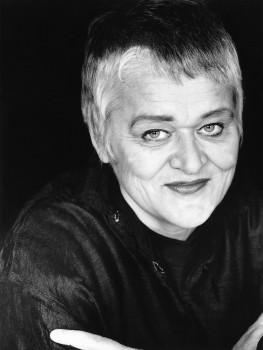Contrapuntal dialogue
Issue 2/1985 | Archives online, Authors

Pirkko Saisio. Photo: Laura Malmivaara
Pirkko Saisio (born 1949) is the author of five novels and a number of plays. Her first novel, Elämänmeno (‘Way of life’), appeared in 1975, when she was a young actress just graduated from the Finnish Theatre School, appearing in rep at Rovaniemi Theatre. By the time her next novel, Sisarukset (‘Sibling’), was published in 1976, Saisio had moved back to her native Helsinki and was working as a freelance writer and actress.
In addition to three stage plays, she has also adapted three of her novels for stage or television: Elämänmeno was shown on television in 1978 and Sisarukset in 1980, and the KOM Theatre staged its own highly acclaimed interpretation of her novel Betoniyö (‘Concrete night’, 1981) in 1982. Last year Saisio published a new novel, Kainin tytär (‘Daughter of Cain’), whose absence from the Finlandia Prize shortlist astonished many critics. In March her play Hävinneiden legenda (‘Legend of the lost’) was published as a book and staged at the KOM Theatre. Saisio herself appeared in the production, playing, among others, the role of Joan of Arc. In May she was awarded a Government Literature Prize for Kainin tytär.
Saisio’s first novel attracted attention for its descriptions of characters and their surroundings. The book tells the story of a working class family in postwar Helsinki, and Saisio traces the development of the eldest daughter with a great deal of sensitivity. Sisarukset is about the life of two sisters during the Second World War: one is sent to prison for her left-wing activities. Both novels were also published in Sweden, Elämänmeno in 1979 and Sisarukset in 1981. Kadonnut aurinko (‘The lost sun’, 1979) is a novel about a theatre company in a northern Finnish city in which a grand new theatre is being built. The story is not, indeed, without tragicomedy or verisimilitude: Rovaniemi’s new theatre was opened in 1975. Betoniyö describes the lives of two brothers in the concrete jungle of contemporary life; the younger brother Simo is an adolescent who lacks all the interpersonal relationships that make development possible; he has no way of expressing himself or of understanding the world in which he lives, and in the end he is driven to commit suicide. In Betoniyö Saisio uses mostly dialogue; the form is dramatic. The novel draws a chilling picture of the urban jungle, and her writing has become more compact and, at the same time, more spacious.
Kainin tytär is the story of a relationship between two women, of opposites, of art and artists. Anna and Risku are musicians, Risku a pianist and a teacher at the Academy, Anna a cellist, a student. Risku is from a Russian orthodox home, Anna the daughter of a Lutheran priest. In the novel each of the characters spends a night pondering the development of their relationship, their own past. The cruel stone labyrinth of the city is oppressive to those who flee from themselves, whether alone or in their relationship with someone else. Saisio’s slim but profound novel is about development, movement, learning and travelling in time and in life: ‘All joy is in the travelling, there’s nothing in the goal,’ says a fellow musician to Anna at one point in the book.
Saisio’s characters are children of the city, either crushed by it or adapted to it; Saisio is an urban writer – the ‘romance of the countryside is conspicuously absent from her prose. The author, with her sensitive ear for the nuances of speech, retires to the background and lets her characters reveal themselves: Saisio, actress-writer, dramatist, deals in dialogue.
Translated by Hildi Hawkins
No comments for this entry yet
Leave a comment
Also by Soila Lehtonen
Colour me beautiful? - 29 June 2015
Leena Krohn: Erehdys ['The mistake'] - 8 June 2015
Minna Lindgren: Ehtoolehdon tuho [The downfall of Twilight Grove] - 1 June 2015
Pekka Lassila: Maininki [Surge] - 5 May 2015
-
About the writer
Soila Lehtonen is a journalist and theatre critic and the Editor-in-Chief of Books from Finland from 2007 to 2015. She edited a collection of writings about the city of Helsinki together with Hildi Hawkins, Helsinki: a literary companion (The Finnish Literature Society, 2000).
© Writers and translators. Anyone wishing to make use of material published on this website should apply to the Editors.
